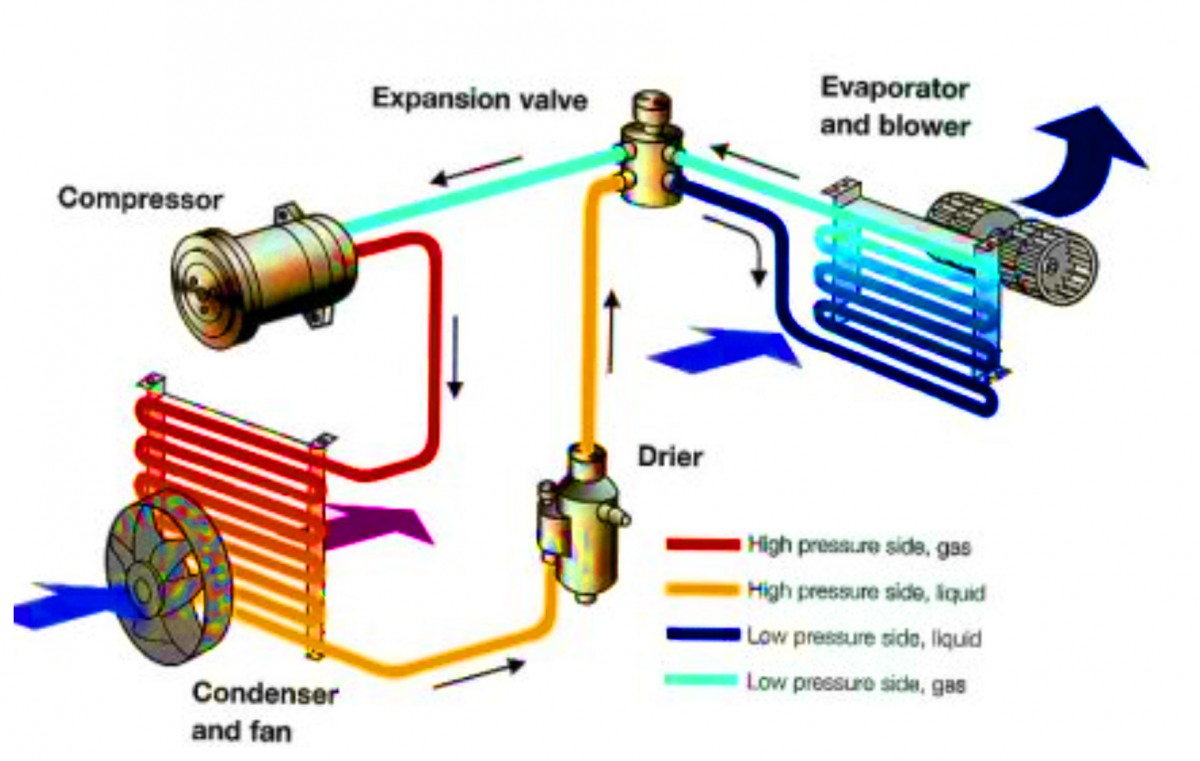 A
decade ago, the air-conditioning (A/C) system was an extra feature in a vehicle
just like the heated seats, a full airbag system, the reverse camera and
sensors… However, nowadays it has become a necessity because of many aspects,
such as the huge increase of cars on the roads causing loads of traffic jams
and the amount of jobs requiring a long time driving in the hot weather.
A
decade ago, the air-conditioning (A/C) system was an extra feature in a vehicle
just like the heated seats, a full airbag system, the reverse camera and
sensors… However, nowadays it has become a necessity because of many aspects,
such as the huge increase of cars on the roads causing loads of traffic jams
and the amount of jobs requiring a long time driving in the hot weather.
The A/C system consists of numerous parts
that differs between automotive brands:
- The
compressor: Increases the pressure of the refrigerant in the system.
- The A/C
hoses (High and low pressure): Connect all the system’s components to create a
closed loop
- The
condenser: Cools the refrigerant
- The fans:
Blow cold air through the condenser
- The
receiver dryer OR The accumulator: Removes the moister from the system
- The thermal
expansion valve OR The orifice tube: Regulates the flow of the
refrigerant in order to expand it and reduce its pressure.
- The
evaporator: Absorbs the heat from the cabin to cool the refrigerant and turn it
into gas (You might see ice forming on this component)
- The blower:
Blows cold air from the evaporator into the cabin
Figure
1: Air-conditioning system diagram
The system works by changing the pressure
of the refrigerant gas which affects its temperature, this pressure-temperature
relation is similar to a sprayer can getting colder when spraying for a long
period of time. According to Guy-Loussac’s law, pressure and temperature are
proportional, hence a low-pressure gas has a low temperature (cold) whereas
high pressure gas inflicts a high temperature (hot).
The air coming out of the vents has always
the same temperature. The temperature set on the A/C panel (Marked in blue in figure 2) is the desired cabin temperature. Consequently,
once the actual temperature of the vehicle’s cabin reaches the desired one, the
A/C compressor shuts off.
The recirculation loop button (Indicated in red in figure 2)assure a closed loop air system by preventing any
outer air (Mostly hot) coming into the cabin which allows the air-conditioning system to transform the hot air inside your cabin to cold air.
The A/C button switch (Circled in yellow in figure 2) turns on and off the compressor manually.
The A/C button switch (Circled in yellow in figure 2) turns on and off the compressor manually.
Figure
2: Air-conditioning panel
Although the manufacturers are developing
more efficient A/C systems, it remains the most fuel consuming feature in a
vehicle when turned on (an increase of up to 20%), and that’s due to the fact
that the compressor’s pulley is rotated by the drive belt that is connected to
the crankshaft pulley which adds load on the engine.
Nevertheless, it is possible to reduce this
increase of fuel consumption, here some tips:
- Adjust your
thermostat settings to a comfortable temperature rather than a cold one.
- Always use
re-circulation to cool only the air inside the car
- Open the
windows without any A/C at start-up (For few minutes)
- Park your
vehicle in the shade or use window shades to reduce the heat inside the car
References:
- Did It Myself. (2019). Recharging Car Air Conditioning - Did It Myself. [online] Available at: https://did-it-myself.com/recharging-car-air-conditioning/
- Completely Firestone. (2019). All About Your Car's A/C System | Firestone Complete Auto Care. [online] Available at: https://blog.firestonecompleteautocare.com/maintenance/everything-you-need-to-know-about-your-cars-ac/
- Nrcan.gc.ca. (2019). Vehicle air conditioning | Natural Resources Canada. [online] Available at: https://www.nrcan.gc.ca/energy/efficiency/energy-efficiency-transportation-and-alternative-fuels/choosing-right-vehicle/tips-buying-fuel-efficient-vehicle/factors-affect-fuel-efficiency/vehicle-air-conditioning/21030

